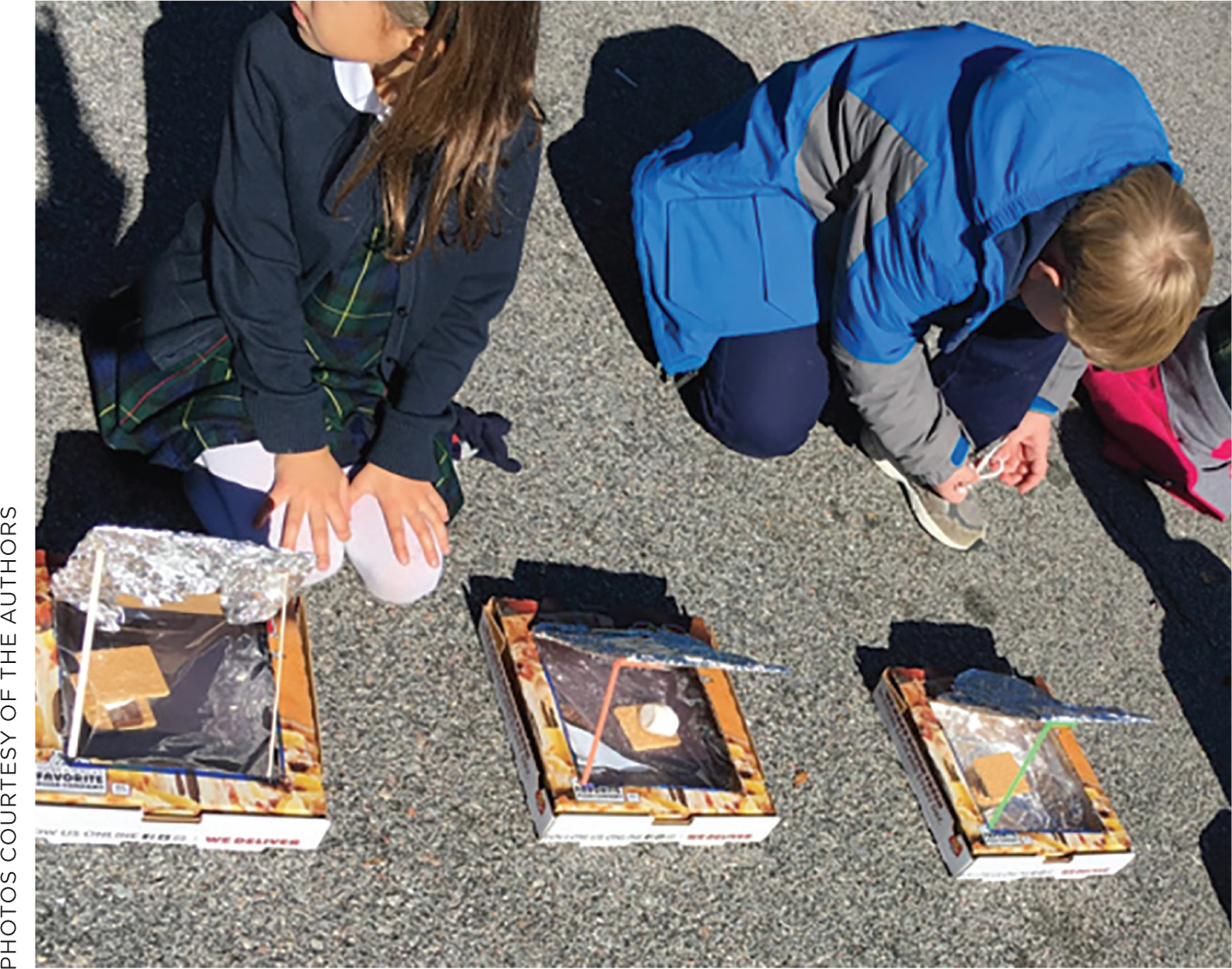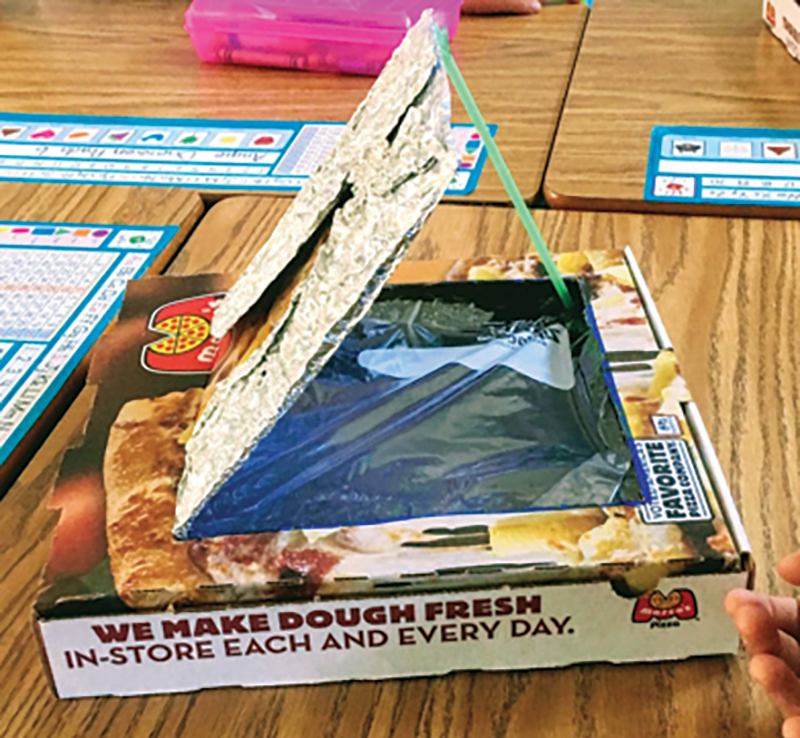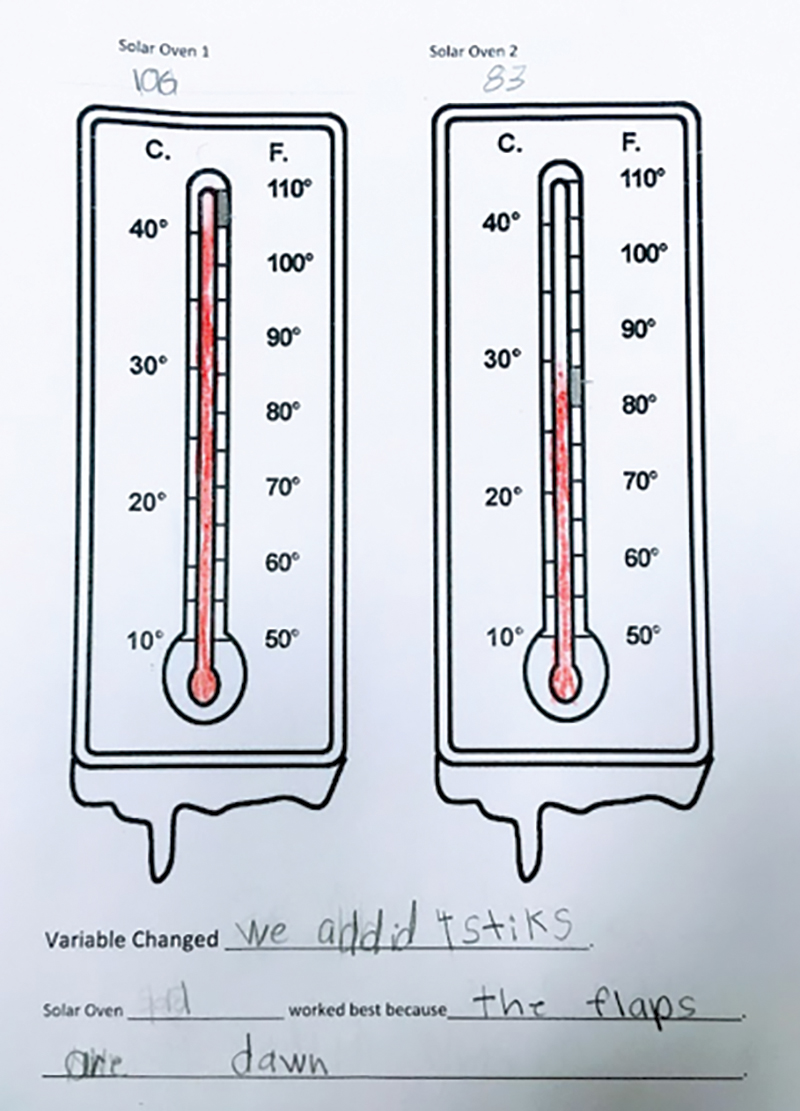Engineering Encounters
Look, It’s Changing!
Engaging in engineering design to explore energy
Science and Children—July/August 2020 (Volume 57, Issue 9)
By Bridget Miller, Christie Martin, and Diane Ford
Mrs. Ford’s first-grade class has been investigating light. Earlier in the week, students observed light as it passed through transparent, translucent, and opaque materials. Mrs. Ford’s students were eager to respond when she asked “What do we know about light?” Students shared ideas such as “Light can travel through a window,” “Windows are translucent!” “Stained glass is translucent and only lets some light through,” “It’s a type of energy,” and “When light is blocked we get a shadow.” Mrs. Ford’s students were able to communicate how light acted when different materials were placed in its path. She wanted to expand on students understanding about light as energy. Through the engineering of two solar ovens, students engaged in engineering design practices, applying what they knew about light and energy. Mrs. Ford used a variety of modeling and driving questioning to promote critical thinking and problem-solving among her students.
Before describing the next few days of engineering design, it is worth noting the materials for the investigation and suggestions for classroom management. The materials include: pizza boxes, foil, straws, coffee stirrer, tape, different color paper, plastic bag, ingredients for s’mores, notebook, and pencils. Mrs. Ford asked a nearby pizza chain restaurant in advance for 40 small boxes; the restaurant owners decided to forgo the small cost and donate the boxes. Classroom management impacts the success of the lesson. In this first-grade classroom there were 18 students, a teacher (Mrs. Ford) and teacher’s aide (Mrs. Harper). They both walked around working with small groups. Students were placed with partners they had success working with in the past. By working in partners, students were able to take ownership of the subject matter, and this also helped facilitate management. They developed teamwork and communication skills. The content was reinforced as students worked together and taught each other with retention of content being higher because they were presented with numerous opportunities to explain their thinking. Mrs. Ford stated tasks and expectations and used modeling to ensure students were poised to effectively engage in the exploration.

Students test solar ovens.
Day 1: Engage
Mrs. Ford shows students a model (a prototype) of a solar oven (Figure 1) and guides students, “Do you think we could use the Sun to cook, making a solar powered oven?” She then probes students “What do you notice about this model of a solar oven?” Students made observations about what they saw. One student says, “It is propped open,” while another student adds, “The Sun is going to reflect off the foil and go through the clear plastic.” Mrs. Ford continues to guide students “Why do you think I would have the clear plastic enclosing the box?” Students share ideas and talk about the light getting out, so she prompts a bit about what else might escape —they all realize that the heat will escape. Mrs. Ford reinforced the idea that many things that give off light can also give off heat. She showed how the inside of the box is lined with a black piece of paper and she asks why that might be. Students suggest that the black paper will absorb the light. The students had engaged in lessons regarding light absorbtion and how light travels through materials (i.e., transparent, opaque, reflective, DCI PS4.B and DCI PS3.B) in the previous school year).

Baseline oven.
Mrs. Ford introduces the design challenge to the students: “Tomorrow we are going to work to build your own solar oven.” She explains that they will work with a partner to decide on one variable to change in the design that they believe will help the oven get hotter faster. She shares that the more quickly their oven heats up, the faster their s’mores will cook. The students are required to draw scientific models of their plan that include labels and a sentence or two to describe their plan. They will have to indicate the variable they are changing and why they think that will work. Due to time constraints, they are making their predictions and engineering their solar ovens in class. They will then test the original design (ovens made on the second day) against their re-engineered version under the same conditions (ovens made on the third day).
Mrs. Ford goes over the materials they will have access to (pizza box, foil, straws, coffee stirrer, tape, different colored paper, and plastic bags). The materials were shown and presented on a long table. Students begin working on their drawings. Students drew the original solar oven model, and labeled the different parts, and how they thought the oven would work such as, “We are going to use more foil.” Mrs. Ford reminded them “I want you to think about what we know about light to draw how you think the solar oven can use the sunlight to cook.” Students indicated ideas such as “the foil will reflect the light into the oven,” and “the sticks will open the lid more to let light pass in through the plastic. It can’t go into the lid.” To compare the rate at which the ovens heat, students will simultaneously test both their baseline ovens and their redesigned ovens at the same time.
Day 2: Design
The following day, each student made their own baseline solar oven, starting by making the same solar oven as Mrs. Ford. Students worked in pairs with their pre-assigned classroom partners. As students worked, Mrs. Ford and the classroom assistant walked around the classroom and formatively assessed student thinking by observing students’ work and asking guiding questions.
After making baseline models, students were challenged to alter the original design by changing a variable (i.e., color of paper lining the box) to make their oven work “better.” During whole-group instruction, Mrs. Ford reiterated that “better” in this case meant it would get warmer and cook faster. Students shared ideas about what variable they would change and why they thought it would help the oven absorb more heat energy. Students’ ideas included changing the foil area to be plastic, changing the plastic to foil, changing the black paper with the foil, changing the angle with the opening, changing the color of the paper and adding a straw to prop the open the oven more.
Safety note
During this lesson on solar ovens, several safety precautions were taken. The instructor discussed safety procedures regarding not using reflecting surfaces to shine the Sun into other’s eyes. Students were directed to walk and remain in the testing area (basketball court) during the activity. Digital thermometers were not placed into the ovens until they were outside and placed on the ground. The teacher assisted in placing thermometers into the solar ovens. Thermometers were removed from solar ovens prior to students carrying ovens back to the classroom.
Day 3: Redesign
Once students completed their initial ovens, they were challenged to change a variable that they felt would make their solar oven work better. Students brainstormed what variables might impact the performance of their ovens. Mrs. Ford engaged in a group discussion with her students regarding possible changes and reiterated that cooking faster would be the goal of the changed variable. She also informed students that they would get to test their ovens ability to cook s’mores. Students then worked in pairs to identify possible changes. Students drew their ideas and showed their thinking through diagram and discourse with their partners. Scientific models including labels and written explanation served to push their reasoning. To assess students thinking, Mrs. Ford met with each group to listen, view their drawings, and read their explanations of how the changed variable might improve on the original design, such as, “I think the solar oven will cook faster because it has a warm bottom and a warm top layer.”
Mrs. Ford’s first graders used scientific models to explain and communicate their ideas to their teachers and their peers. Scientific modeling plays a large role in science education (Miller and Krockover 2015). From the time we are infants, we try to make sense of what we see and make decisions based on how we interpret what we see. Younger learners can be supported to make sense of information and problem-solve through the use of peer collaboration, teacher facilitation, and the use of scientific modeling to explain and communicate. For students to successfully problem-solve, they must be able to understand, interpret, and evaluate information (Bristor and Drake 1994). Mrs. Ford’s first graders were using their scientific models to communicate their understanding of how light would act when different parts of the solar oven entered its path. Students’ models provide both a way to obtain information as well as a tool to communicate information
Day Four: Data Collection and Analysis
Students explored a variety of variables to change in their solar ovens. Some students lined the inside of the box with aluminum foil, other students used red vs. black paper at the base of their ovens, while others changed the angle (using straws) of the lid to direct light downward. Students once again verbally explained the changes they made and how they thought the changed variable would affect their oven’s performance. Prior to taking their solar ovens outside to test, Mrs. Ford engaged in discussion with students, “What other variables outside should we consider when placing our ovens on the basketball court?” Students identified that they would want to be in the Sun, and that their openings should be facing toward the Sun, not away. Students then went out to the playground basketball blacktop and positioned their solar ovens. “Mrs. Ford explained that thermometers would be used to measure the level, or amount, of heat in their ovens.” Digital thermometers were used to collect data on changes in average heat energy (temperatures). To start, the outdoor temperature was recorded at 70 degrees. Students observed their solar ovens, looking for signs of “cooking” (melting chocolate) as well as changes in their thermometers over five-minute intervals for 15 minutes. Students were comparing the difference in heat absorption and immediately began calling out changes in their thermometers readings, “Look, it’s 89!” Students were excited to call out their temperatures as they watched the numbers increase. One student’s thermometer continued to increase to read 95. Students began to inquire why this student’s oven was getting so much warmer than the others. This observation opened the discussion, what variable did this student change? Who else changed this variable? Solar ovens were observed for 15 minutes. The teacher went around and assisted in writing the current thermometer readings on the oven lids prior to returning to the classroom.
Once back in the classroom, students used a handout with two blank thermometers and a writing prompt (Figure 2). Although digital thermometers were used to measure heat energy outside, images of traditional alcohol thermometers were used on the handout to help students visually identify changes and make comparisons across their data. On the handout, students wrote the variable they changed and recorded the final temperature of the first solar oven and the final temperature of the second oven with the changed variable. Students then looked at changes between the two thermometer readings on images of traditional alcohol thermometers and communicated their findings. For example, “Solar Oven 2 worked best because we put two pieces of foil. It absorbed more heat.”

Data analysis.
Mrs. Ford engaged in formative and summative assessment over the course of the lessons. The discussion and journal entries were used to assess students and Table 1 includes a checklist of what Mrs. Ford was focused on in reviewing their work. Students made representations of their data, worked to make sense of the data, and communicated their findings. By measuring the change in heat absorption using the thermometers, students were able to identify that foil reflected more radiation from the Sun, allowing the air to absorb a greater amount of heat energy. Students’ revised scientific models supported student thinking, allowed for comparisons between groups, and opened more discussion.
| Table 1. Summative checklist. | ||||
|---|---|---|---|---|
|
This lesson engaged students in engineering design and pushed them to communicate their plans, predictions, designs, and redesigns. Mrs. Ford’s first-grade students were able to apply what they knew about light in the engineering of their solar ovens. Students used multiple representations to communicate their learning, from their scientific models, to their thermometer analysis.
Conclusion
In the process of reflecting and planning for the teaching this unit again, we are considering modifications such as: (1) building one baseline model and testing it, followed by a redesign session, (2) extending the disciplinary core idea with an activity that directs students to record what happens when light hits varied surfaces, including having them touch these surface to see how they feel related to temperature.This could be done in between measuring temperature of the ovens outside and (3) extending the summative assessment and evaluation to obtain a greater sense of student understanding of core concepts. For example, students could make brochures or advertisements demonstrating how their oven designs work that include scientific models.
Bridget Miller (btmiller@mailbox.sc.edu) and Christie Martin (MARTINC1@mailbox.sc.edu) are associate professors at the University of South Carolina in Columbia, SC. Diane Ford (dford@stjosdevine.com) is a first-grade teacher in St. Joseph School District in Columbia.


